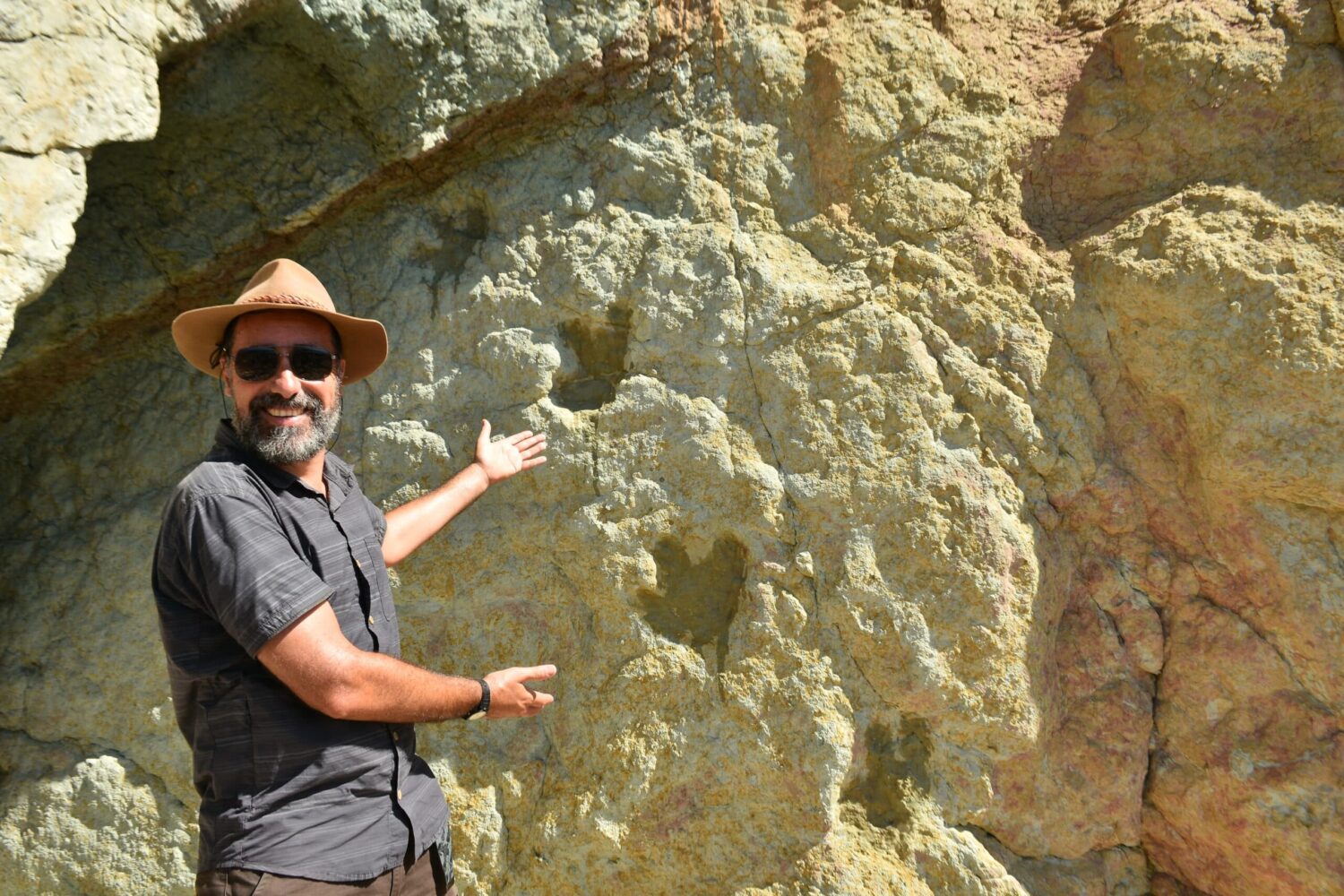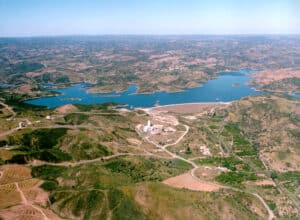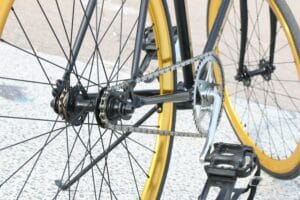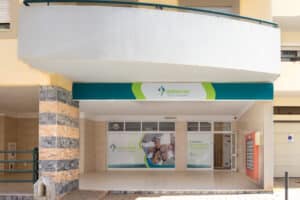“Praia dos Arrifes is clearly going to be one of the world’s most important geosites” – Octávio Mateus, palaeontologist
A stunning new discovery of 120-million-year-old dinosaur footprints at Praia dos Arrifes in Albufeira has thrust the aspiring Algarvensis Geopark into the global spotlight, bolstering its bid for recognition as a UNESCO Global Geopark.
This incredible find, which includes 12 well-preserved footprints from multiple dinosaur species, is being hailed as a significant contribution to palaeontology, with experts predicting the site will soon be recognised as one of the world’s most important geosites.
Found within an incredible rock formation that looks like it came straight out of a Jurassic Park film, and which is only accessible during low tide, the footprints have turned Praia dos Arrifes into a central location for the study of dinosaurs in Portugal.
“This is a top discovery,” Octávio Mateus, a palaeontologist and a professor at Lisbon’s Nova University, says. “Praia dos Arrifes is clearly going to be one of the world’s most important geosites.”
What is even more fascinating is that the area is home to footprints belonging to “several types of dinosaurs, all from the Lower Cretaceous, dating back around 120 million years.”
The footprints are hidden between two vertical layers in the cliffside, where “footprints made in mud were gradually covered by limestone and sand. Over time, as the lower sediment eroded, the natural mould in the limestone remained,” the palaeontologist explained.
Mateus, who also serves as a scientific advisor for the Geopark Algarvensis project, has identified five distinct animals represented in the tracks, including small herbivorous sauropods and predatory carnivores.
“We have a sauropod trackway with both foot and handprints, intersected by three carnivorous dinosaur tracks. So, there were four animals which possibly travelled through here. This arrangement of foot and handprints and the morphology of each print is something I’ve never seen before, which doesn’t mean they do not exist elsewhere in Portugal, just like they do here,” Mateus explained, adding that detailed 3D photogrammetry has been used to digitally capture these ancient relics for further study.

Printed into another nearby rock are four other tracks, measuring around 25 centimetres and believed to belong to an herbivorous ornithopod dinosaur, likely similar to an Iguanodon. “This means that the animal that made them would have stood about one-metre tall at the hip and measured four metres in length. This group of animals, and this one in particular, is similar to an Iguanodon. It’s the same as those found at Praia da Salema (Vila do Bispo), but also near Sintra, at Praia Grande do Rodízio, and in Óbidos, at Praia dos Olhos de Água. They are important and spectacular because they are very visible, though they are more common than sauropod dinosaur footprints,” the specialist explained.
However, establishing exactly when and by whom these footprints were discovered is a challenge, Mateus admitted.
The first site, with the 12 footprints, was documented in 2016 but had not been studied until now, with research being conducted as part of the Algarvensis Geopark’s bid to join UNESCO’s Global Geoparks Network – a project uniting the municipalities of Loulé, Silves, and Albufeira.
“The site with the sauropod footprints in the crevice was first mentioned in a conference summary in 2016 (Santos et al., 2016) and considered the first mention (though it doesn’t specify who discovered them),” says Mateus.
Meanwhile, Paulo Fernandes, a professor at the University of Algarve (UAlg) and the current scientific coordinator of the Algarvensis Geopark, stated that the discovery was “revealed during one of his field classes by a student,” though he is not sure about the date. “I thought it was from the early 2000s, but it must have been between 2014 and 2016.” However, as far as he is aware, “the ornithopod footprints are completely new and were discovered by me on June 12, 2014”.
Another fascinating detail about the discovery is that the footprints are all found vertically on rocks. The explanation is simple – and does not involve dinosaurs climbing cliffs as if they were Spider-Man.
“There are tectonic forces related to the Albufeira Diapir, or crustal movements, that caused the layers to fold and rotate. What was once located horizontally is now vertical. The entire area of Praia dos Arrifes is fantastic because we have an exhibition of very fossil-rich rocks – vertebrates, invertebrates, plants, pollens, microorganisms, and many animals. There is a sequence of relatively thin layers where it’s very easy to understand what happened over time. We have several million years recorded in the rocks there, and it’s not always so easy to see that. This is the best site in Portugal to teach stratigraphy (a branch of geology concerned with the study of rock layers (strata) and layering (stratification),” Octávio Mateus said.
He also elaborated on what makes Praia dos Arrifes stand out. “It was eroded by the sea and contains more recent rocks, which creates an angular unconformity between the Cretaceous rocks and those from the Miocene, which are much more recent, with another layer from the Pleistocene, about two million years old. This is an incredible place to understand the planet’s history,” the palaeontologist said.
At the beach, there are also traces of shells, half centimetre-sized unicellular organisms, and rocks with vestiges of bioturbation – put simply, the reworking of soils and sediments by animals or plants.
“There is a rock that was once a seafloor where crustaceans, similar to crabs and lobsters, made burrows and dug into the sand. Today, we have the tracks of these invertebrates. It’s spectacular,” the researcher adds.
While the footprints are a thrilling addition to the Algarve’s palaeontological record, they also present a conservation challenge. The location of the main trackway, in particular, is vulnerable to erosion from the sea, the palaeontologist said, warning that without intervention, these ancient tracks could be lost within a decade. Resorting to chemical consolidation – the application of chemicals to the footprints to help their conservation – is among the possible solutions to protect the footprints from the forces of nature.
Meanwhile, the discovery of these footprints comes at a critical time for the Algarvensis project, which just recently welcomed experts from UNESCO who travelled to the Algarve to see its progress.
“The most important aspect of the Geopark Algarvensis project is its strategy for sustainable development,” Mateus said, stressing that there are certainly more historic treasures waiting to be found in the Algarvensis territory – such as the “the basalt (rock) from the volcanoes that marked one of the great mass extinctions,” visible in the São Bartolomeu de Messines/Vale Fuzeiros area in Silves.
The final application is due to be submitted later this year, with a decision expected in 2025.


























